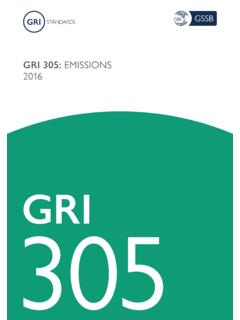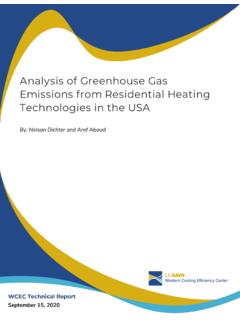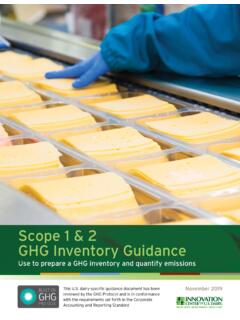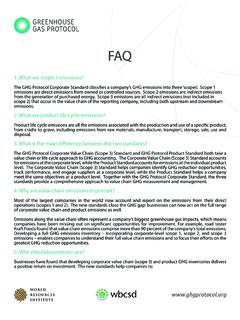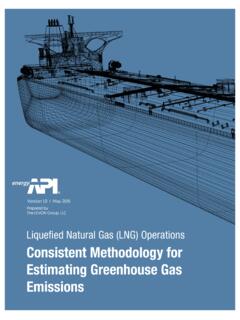Transcription of CLECAT Guide on Calculating GHG emissions for freight ...
1 Calculating GHG emissions for freight forwarding and logistics services in accordance with EN 16258 Terms, Methods, Examples 2 Calculating GHG emissions for freight Forwarding and Logistics Services Calculating GHG emissions for freight forward-ing and logistics services (April 2012) Authors: Martin Schmied, INFRAS Forschung und Beratung, M hlemattstrasse 45, 3007 Bern, Switzerland (E-Mail: and Wolfram Kn rr ifeu Institut f r Energie- und Umweltforschung Heidelberg GmbH, Wilckens Stra e 3, 69120 Heidelberg, Germany (E-Mail: Editor: Christa Friedl, Wissenschaftsjournalistin Krefeld, Germany (E-Mail: Translation: Lynda Hepburn, BSc, MSc, MITI Freelance science translator 7/2 Shandon Street, Edinburgh EH11 1QH, United Kingdom (E-mail: Published by: European Association for Forwarding, Transport, Logistics and Customs Services ( CLECAT ) The R&D project which forms the basis of this Guide was carried out under contract to the German Federal Ministry for the Environment, Nature Conservation and Nuclear Safety (BMU).))))
2 Responsibility for the content rests with the authors. The information provided in this Guide was carefully researched, processed and checked. However, no undertaking can be made that all information shown is complete, correct and up-to-date at all times. CLECAT expressly points out that this Guide contains only general information and in no way replaces legal or other advice for taking measures in individual cases which are made on the basis of the technical information contained in this Guide . CLECAT and the authors are exempt from liability except for deliberate or grossly negligent false information. The contents of this Guide are protected by copyright. No use is permitted outside the strict limits of the copyright law without agreement of the author and any such use is liable to prosecution. This applies in particular to reproduction, editing, translation, microfilming and storage and processing in electronic systems.
3 CLECAT Calculating GHG emissions for freight Forwarding and Logistics Services 3 Contents 1 Guide to the Guide .. 7 2 Climate protection and carbon footprints in logistics .. 12 3 Before you start the most important principles .. 15 4 Standards and norms what framework is there? .. 18 5 Determining standardised consumption values and emissions .. 25 6 Allocation: consumption and emissions from individual consignments .. 31 7 Calculation methods for transport services two ways, one aim .. 36 8 Measuring energy consumption what you need to do .. 39 9 Reaching your goal quickly without own measured consumption data .. 41 10 Detailed distance-based calculations for lorries .. 49 11 Calculations for buildings, warehouses and handling .. 53 12 Results what next .. 58 13 Additional helpful Information .. 61 4 Calculating GHG emissions for freight Forwarding and Logistics Services Introduction by CLECAT , the European Association for For-warding, Transport, Logistics and Customs Services Transport is responsible for over 30% of final energy consump-tion.
4 Management and reduction of energy consumption in transport are key societal challenges in relation to climate change and security of supply. Standardization provides tools to support the various stakeholders in managing those challenges. CLECAT is therefore pleased to present to its members and oth-er interested parties the English edition of the DSLV Guide Cal-culating GHG emissions for freight forwarders and logistics ser-vices , which provides for a practical tool for logistics service pro-viders that seek to make use of the CEN standard in order to de-termine their environmental footprint and seek ways to reduce it. Anyone with experience in the measuring of the carbon footprint of logistics knows that this can be complicated, not the least be-cause up to now there has been no standard way of doing it. The publication of the CEN standard EN 16258, covering a "Methodology for calculation and declaration of energy consump-tion and GHG emissions of transport services ( freight and pas-sengers)" earlier this year was therefore welcomed by CLECAT .
5 We are convinced that a standardised calculation methodology will benefit industry, facilitate communication on the results and enable comparisons of energy consumptions and GHG emis-sions of different transport operations realised by companies. The CEN standard provides for a common approach and frame-work for the calculation and declaration of energy consumption and emissions for transport services irrespective of the level of complexity. The standard includes standardised procedures for Calculating emissions for the transport of individual consignments and partial loads and methods for determining data for sub-contractors. However, the standard remains complex and theo-retical. We are therefore pleased to support our members with implementation guidelines providing further operational details. It is quite clear that industry will benefit from being pro-active in this area as climate change will not go-away but remain an im-portant transport policy issue.
6 Ambitious targets have been set at EU level to cut GHG emissions by 2020 and 2050. However, sectorial GHG- emissions have not been set but this is likely to happen in the future. Significant efforts have already been made by industry to im-prove the energy efficiency of freight transport. These gains in energy efficiency have however not been sufficient to outweigh the growth in emissions caused by larger transport freight vol-umes, due to a strong increase in global trade and the further in-tegration of the enlarged EU. A mere transfer of goods transport from the road to alternative modes of transport will not be suffi-cient to mitigate large quantities of GHG emissions , and will have CLECAT Calculating GHG emissions for freight Forwarding and Logistics Services 5 just as little effect as an increased use of biofuels, because the potential of both measures in its own right is too limited.
7 It is the combination of a number of measures taken by industry that will eventually lead to a significant reduction in GHG emissions . Companies are increasingly seeking to reduce their footprint which is suiting both economic and environmental objectives. Even when the motivation to reduce energy consumption may ini-tially be economic, improved efficiencies in the supply chain have positive effects on the environment. Only with a uniform stand-ard can industry understand how and where the optimum emis-sion savings can be made in their supply chains. At the same time CLECAT is of the opinion that governments should continue to look at technology development, strengthened research into new technology and fuels, increased use of infor-mation technology and integrated mobility management as well as a wide variety of non-technology policy tools with potential to improve economic efficiency and reduce emissions .
8 Simply measuring emissions is not an end in itself. As in every other sector, the calculation of GHG emissions in goods transport and logistics is the first step to understanding and subsequently reducing emissions . This will support in further advancing reduc-tion or avoidance strategies. A standard is not set in stone and will need to be reviewed on a regular basis. At the same time, voluntary initiatives such as Green freight Europe, will need to integrate the standard in its system. Also, we hope that individual Member States and in par-ticular France who has been in the driving seat at European lev-el, and the first to make the measuring of emissions in transport mandatory, will bring the values included in its legislation in line with the European standard. We would like to thank the DSLV for offering CLECAT the oppor-tunity to publish the updated English version of the guidelines.
9 Special thanks are also due to the German Federal Environmen-tal Agency and the German Federal Ministry for the Environment, Nature Conservation and Nuclear Safety for providing the fund-ing for the research and the publication of the guidelines. Nicolette van der Jagt Director General CLECAT 6 Calculating GHG emissions for freight Forwarding and Logistics Services Introduction by the German Federal Environment Agency (Umweltbundesamt) freight traffic is essential for supplying companies with raw mate-rials and upstream products, and consumers with durable and consumable goods. It is an important requirement for production based on a division of labour and for a broad range of goods. The closer the trade links between regions and the further apart these regions lie, the more freight transport takes place. The total freight transport volume in Germany as a product of the quantity and distance transported rose by around 22 per-cent between 2000 and 2010 and will probably continue to in-crease over the next few decades.
10 In a forecast to the year 2025, the Federal Ministry of Transport, Building and Urban Develop-ment therefore assumes a growth in road freight transport ser-vices of 79 percent compared to 2004. One disadvantage of this development is the increase in the negative environmental ef-fects of freight transport in particular the production of envi-ronmentally damaging carbon dioxide (CO2). The freight transport sector needs to make a larger contribution to reducing CO2 emissions than it has in the past. One fundamental re-quirement when developing initiatives to reduce emissions in lo-gistics companies is to know the scope and origin of the compa-ny's CO2 emissions . This shows where and how the energy con-sumption and therefore the emissions can be reduced most effi-ciently. This produces not only direct cost-savings but also a competitive advantage when the commitment to the environment is relayed to the clients.

